WASHINGTON — William Thomas first introduced fanny to brick on the White House sidewalk on June 3, 1981. His sign said, "Wanted: Wisdom and Honesty." He's been there ever since, still squatting, still wanting.
A few months after he began, he was joined by Concepcion Picciotto, who has remained similarly steadfast.
War is not over, but the peace protesters have won. Sort of. Lafayette Square, the oasis of green across Pennsylvania Avenue from the White House, is theirs.
Get rid of the shelter made of a battered patio umbrella, a weathered plastic tarp and those faded anti-nuke signs erected by Thomas and Picciotto?
It wouldn't be the same park.
Tourists from such places as Beijing and Chicago no longer would flash peace signs for digital cameras. School groups would make one less stop. Tour-guide shticks would shrink by a sentence or two.
Anniversary celebrations are for institutions. The 25th Anniversary Speakout for the 24-7 peace vigil began at noon Saturday, hosted by peace and anti-nuke groups, with speakers and invitations to "sing, chant, recite, drum, dance your heartsong."
A quarter-century. Through rain and sleet and snow and summer. And police raids and lawyers and courtrooms. And jail. Thomas once was sentenced to 90 days for violating the elaborate (and ever-evolving) rules of expression.
But that's all been sorted out. As long as they don't "camp" (dozing off on your stool is OK, but no sleeping in anything that resembles "bedding"), stray more than 3 feet from their signs or construct overly large posters, the law leaves them alone.
The National Park Police and the Secret Service have learned to live with the protesters.
"We make it look like a free country," Thomas said. "We're an asset to the government. So they don't pay much attention and pretend we're not here." They have inspired legislation on Capitol Hill. Every session, Rep. Eleanor Holmes Norton, D-D.C., introduces the Nuclear Disarmament and Economic Conversion Act, calling for nations to mutually agree to disarm. It's based on a ballot proposition that passed in the District of Columbia in 1993 that was inspired by the vigil keepers.
The bill never goes anywhere, but, Norton said, "The reason they have become a fixture is because they are there for the long haul for disarmament."
Colman McCarthy, a former Washington Post columnist who now teaches peace studies, said, "I take my high-school and college students regularly to the vigil. I'd rather they see a sermon on peace than hear one."
The fact that the nation is at war again, that nuclear fear again is in the air, does not take away from the vigil keepers, McCarthy said: "The basic philosophy of the peace movement is not to worry about being successful, but to worry about being faithful. For 25 years these people have carried on a commitment that goes back to Isaiah."
In the beginning, Thomas and Picciotto stationed themselves on the sidewalk next to the White House fence. New rules forced them to the sidewalk on the other side of Pennsylvania. Once every four years, during inaugural parades, they have to move. They also were displaced for the recent reconstruction of the avenue and then allowed back to the new brick sidewalk.
Since the early days, they have split up vigil duties, alternating six-hour shifts so someone is on duty 24 hours a day. Their schedule is at least as rigid as any of the bourgeois clock-punchers who sometimes sneer at their lifestyle. It takes discipline to last 25 years.
When not in the park, the two spend time in Peace House, a group house about 10 blocks away, a space purchased with a little money left by elderly friends several years ago. They do not solicit money. Thomas said he eats donated food and wears donated clothes.
Naturally, there is a Web site,
Prop1.org, Thomas' wife, Ellen, who supports the vigil, posts online diary entries about the effort.
"I never imagined I'd be sitting here for 25 years," said Thomas, 60. "I've always been something of a nomad, and to think I would sit here for so long was something incomprehensible."
His fundamental hypothesis is that the government lies. These lies were used to justify the nuclear-arms race, and they are at the root of all the war-making since, he said.
"I'm not convinced absolutely that I'm not incorrect," he said. "So I sit here and I tell people what I believe, in the hope that if I am incorrect, somebody will come by and explain to me the error of my thinking. Unfortunately, it hasn't happened yet."
Picciotto won't talk to a reporter because she is sure the reporter will print lies. She has said she was born in Spain. Today, she will only say: "We got to stop this insanity. No more invasions."
The peacemakers sometimes get on each other's nerves.
"No pictures," Picciotto tells a news photographer even though tourists have been snapping her all day.
"What is wrong with you?" Thomas asks.
"You think I'm a fool?" Picciotto says.
"Yes, sometimes," Thomas says.


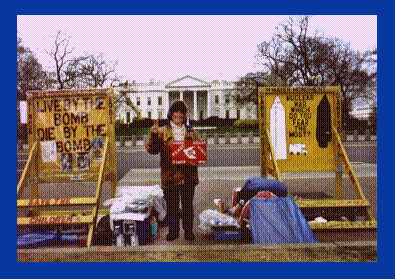

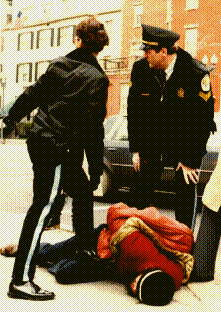
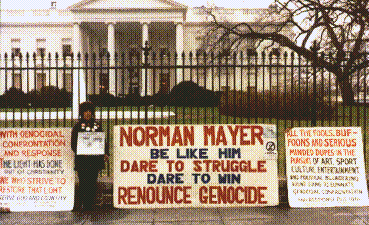
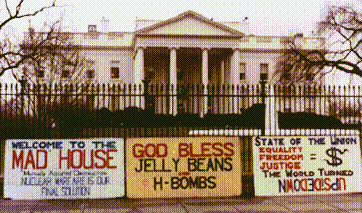
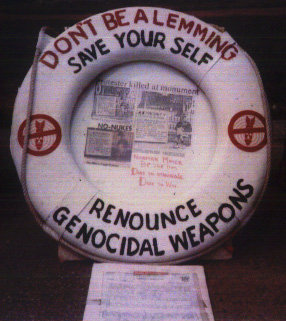
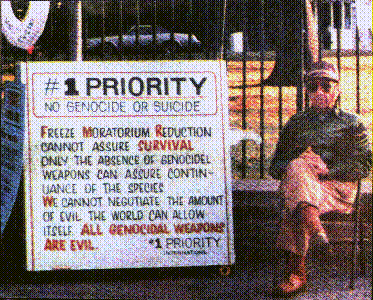
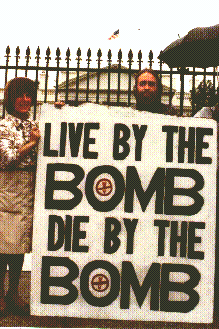
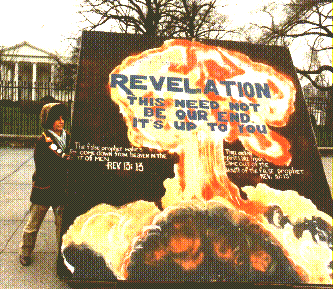 The Washington Times
The Washington Times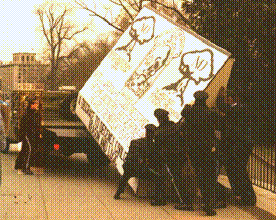 In spite of their resistance, the Park Police and the Secret Service won the battle, and the protesters were forced off the White House Sidewalk:
In spite of their resistance, the Park Police and the Secret Service won the battle, and the protesters were forced off the White House Sidewalk: 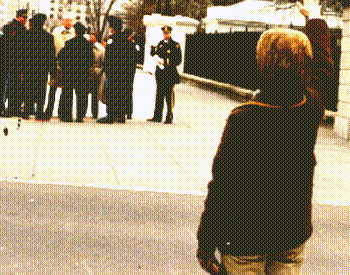 Concepcion salutes the Park Police, Hitler-style, as they take the signs away.
Concepcion salutes the Park Police, Hitler-style, as they take the signs away.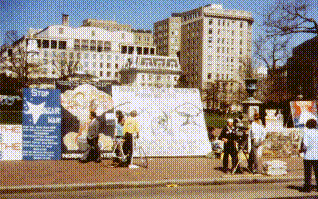
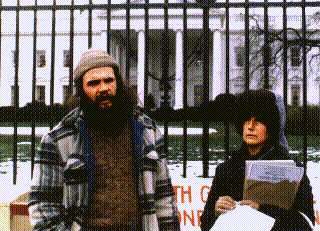 THE NORTH IRELAND TIMES
THE NORTH IRELAND TIMES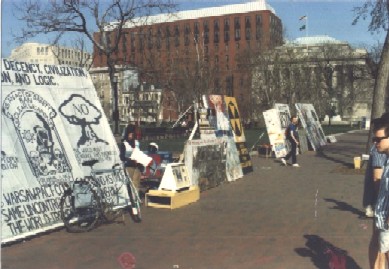

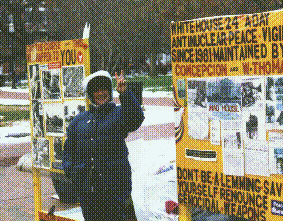
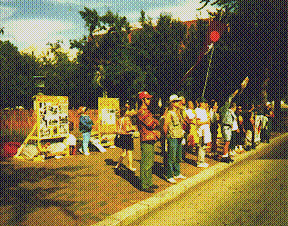
 Concepcion Piccioto, oriunda de Espana, lleva 10 anon dia y noche frente a la Cas Blanca en vigilia permanente por la paz?
Concepcion Piccioto, oriunda de Espana, lleva 10 anon dia y noche frente a la Cas Blanca en vigilia permanente por la paz? 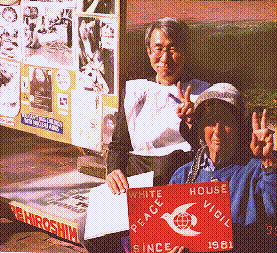
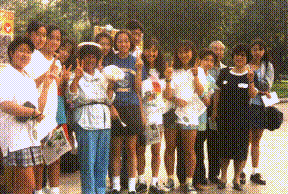

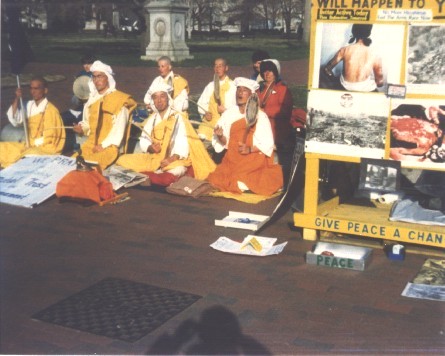
 After gazing at the White House, a group of well-dressed tourists turns around and takes in an entirely
After gazing at the White House, a group of well-dressed tourists turns around and takes in an entirely
 Mr Joseph Mbogo, 45, spent his morning last Tuesday standing, in protest, outside Parliament in a one-man demonstration, but positioned well enough to be seen by those going in or leaving the Parliamentary Building. The former NRA bush war veteran hasn’t had a share in the national cake, the way many of his colleagues have. It’s now 22 years since ‘they’ took power but all he has is the memory of the harsh bush days. “I wrote to the president in August 2007,†he told The Independent in an interview.
Mr Joseph Mbogo, 45, spent his morning last Tuesday standing, in protest, outside Parliament in a one-man demonstration, but positioned well enough to be seen by those going in or leaving the Parliamentary Building. The former NRA bush war veteran hasn’t had a share in the national cake, the way many of his colleagues have. It’s now 22 years since ‘they’ took power but all he has is the memory of the harsh bush days. “I wrote to the president in August 2007,†he told The Independent in an interview. 

 “The great majority of Ugandans live a subsistence life, they cannot prepare for a month ahead, they live by the day and tomorrow may be different,†he said. Ugandans will react in a demonstration massively today and tomorrow they will have got a job or a deal upcountry and they will abandon the cause to go and make money. “Demonstrations are successful in structured economies where people know how they will live at least for a month. That is how dictators are surviving,†said Kyanjo.
“The great majority of Ugandans live a subsistence life, they cannot prepare for a month ahead, they live by the day and tomorrow may be different,†he said. Ugandans will react in a demonstration massively today and tomorrow they will have got a job or a deal upcountry and they will abandon the cause to go and make money. “Demonstrations are successful in structured economies where people know how they will live at least for a month. That is how dictators are surviving,†said Kyanjo.  Concepcion Picciotto in front of her alternative White House on the edge of Lafayette Park, across Pennsylvania Avenue from the real one. (Andrea Lee/CBC) It is 12:30 on a Thursday afternoon and it is hot, one of those searing, humid days that remind Washingtonians they live in the U.S. South.
Concepcion Picciotto in front of her alternative White House on the edge of Lafayette Park, across Pennsylvania Avenue from the real one. (Andrea Lee/CBC) It is 12:30 on a Thursday afternoon and it is hot, one of those searing, humid days that remind Washingtonians they live in the U.S. South.
 El documental "Fahrenheit 9/11" muestra el rostro de la activista, que denuncia desde 1981 el "injusto y corrupto" sistema social de EE. UU.
El documental "Fahrenheit 9/11" muestra el rostro de la activista, que denuncia desde 1981 el "injusto y corrupto" sistema social de EE. UU.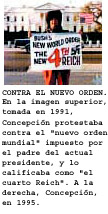 La g�nesis, una odisea
La g�nesis, una odisea Hoy, como cada d�a de los �ltimos 8.400, la acera de Lafayette Park, a la altura del c�lebre n�mero 1.600 de la avenida Pennsylvania, es el hogar de la viguesa Connie. Durante m�s de dos d�cadas, su historia ha protagonizado decenas de reportajes en peri�dicos de todo el mundo. En ellos, adem�s de confesar repetidamente que le gustar�a regresar un d�a a Galicia, ha ido desgranando las complicadas condiciones de vida que ha asumido a cambio de perpetuar su rechazo manifi esto al sistema. Concepci�n vive a la intemperie. Subsiste a base de limosnas y donativos efectuados por simpatizantes de sus causas. Tambi�n vende peque�as piedras pintadas en las que expresa las causas que la mueven a continuar con su vigilia.
Hoy, como cada d�a de los �ltimos 8.400, la acera de Lafayette Park, a la altura del c�lebre n�mero 1.600 de la avenida Pennsylvania, es el hogar de la viguesa Connie. Durante m�s de dos d�cadas, su historia ha protagonizado decenas de reportajes en peri�dicos de todo el mundo. En ellos, adem�s de confesar repetidamente que le gustar�a regresar un d�a a Galicia, ha ido desgranando las complicadas condiciones de vida que ha asumido a cambio de perpetuar su rechazo manifi esto al sistema. Concepci�n vive a la intemperie. Subsiste a base de limosnas y donativos efectuados por simpatizantes de sus causas. Tambi�n vende peque�as piedras pintadas en las que expresa las causas que la mueven a continuar con su vigilia.